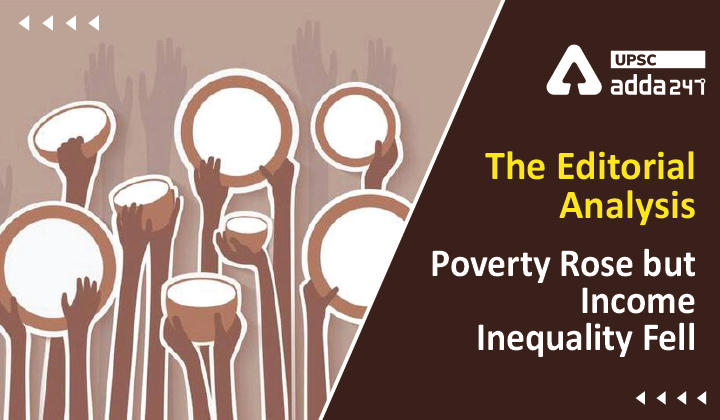Table of Contents
Poverty Rose but Income Inequality Fell- Relevance for UPSC Exam
- GS Paper 2: Governance, Administration and Challenges- Welfare schemes for vulnerable sections of the population by the Centre and States and the performance of these schemes.
Background of Poverty Rose but Income Inequality Fell
- Over two-thirds of the country has been infected by COVID-19 and perhaps five million or so people have died, directly or indirectly, from the pandemic.
- Even though there has been a V-shaped recovery, output remains about 10% lower than in 2019.
- In macroeconomic crises, including the oil shock of 1990-91 or the global liquidity crisis of 2007-08, many expect the poor to bear the brunt of the pain.
Key Findings of Poverty and Inequality During Pandemic
- Poor are the most vulnerable, without contractual protections and adequate safety nets. But there are signs that this pandemic has not followed that script.
- Rise in Extreme Poverty: It rose from 7.6% in November 2019 to 11.7% in July 2021.
- Extreme Poverty: It is defined by the World Bank as the percentage of the population with an income below $1.90.
- Decline in Income Inequality: In 2019, the average monthly income of households in the top 25% and bottom 25% of the income distribution was approximately ₹45,000 and ₹8,000, respectively, in urban areas, and ₹22,500 and ₹7,500, respectively, in rural areas.
- While the average monthly income of the top quartile in urban areas fell almost 30%, to ₹32,500 by July 2021, the monthly income of the bottom quartile in July 2021 remained at pre-pandemic levels.
- In rural areas, the top quartile income fell by perhaps 20%, while the bottom quartile income grew slightly during the same period.
- The result is that inequality, measured as the percentage change in the income of the top quartile minus the income in the bottom quartile, fell by 15-20 percentage points.
- Richer households saw larger drops in income all along the income scale, in rural and urban areas, within each State, and even within caste groups.
The Editorial Analysis: Tackling the Persistent Growth of China
Reason for decline in Inequality
- Role of Government payments: to the poor cannot explain the decline in inequality.
- Households received roughly ₹400 per month in urban areas and nearly ₹500 per month in rural areas during the lockdown and the Delta wave.
- Even when government transfers were netted out from income, income inequality fell by over 20% points by July 2021.
- Decline in Business Profits: It played a bigger role than transfers. The rich saw a larger decline in business income and depended more on that income than the poor.
- While just 7% of a bottom quartile household’s income is from a business, nearly 15% of a top quartile’s household’s income is from a business.
- Unlike labour income, business income is volatile because it is susceptible to changes in demand, and thus to aggregate income.
- Labour income: Labour income is just over 65% and 80% of the income of the top 25% and bottom 25% of households.
- These are larger shares than those of government transfers or business profits.
- While the minimum amount that the poor were willing to accept to take a job fell roughly 40%, the minimum amount fell more than 45% for the rich.
- Demand-fell in the service sector: The rich tend to work in the service sector, and demand for services fell more than demand for other sectors.
- While 30% of workers in bottom quartile households work in the service sector, 45% of workers from the top quartile households do.
- During the pandemic, consumer spending on services fell by 30%-40%, far more than the decline in spending on manufacturing or agriculture.
- Manufacturing sector: It employs a larger share of bottom quartile workers than top quartile ones: 35% versus 15%.
- But manufacturing declined less than 20% during the pandemic.
- The progressive contraction of demand for services swamped the regressive contraction of demand for manufacturing.
The Editorial Analysis: Realising the Potential of ‘Maitri’ and ‘Mateship’
Conclusion
- The reduction in inequality would be a silver lining if it were accomplished by lowering poverty rather than reducing the income of the rich.
COVID19 Pandemic: Omicron variant EXPLAINED





 TSPSC Group 1 Question Paper 2024, Downl...
TSPSC Group 1 Question Paper 2024, Downl...
 TSPSC Group 1 Answer key 2024 Out, Downl...
TSPSC Group 1 Answer key 2024 Out, Downl...
 UPSC Prelims 2024 Question Paper, Downlo...
UPSC Prelims 2024 Question Paper, Downlo...
